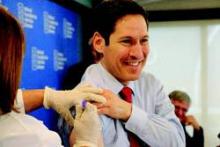WASHINGTON – The best way to fight the flu is to “get a flu shot this year and every year,” said Dr. Thomas Frieden.
Last year was a bad year, especially for adults aged 18-64 years, who had their highest rate of flu-related hospitalizations since the 2009 pandemic, Dr. Frieden, director of the Centers for Disease Control and Prevention, Atlanta, said at a recent press conference sponsored by the National Foundation for Infectious Diseases.
Approximately 150 million doses of flu vaccine are expected to be available this season, and there should be plenty to go around, he emphasized.
The CDC has a three-pronged message for patients and health care providers: Get vaccinated, stay home if you are sick, and take medications if they are prescribed.
Overall vaccination coverage of the U.S. population aged 6 months and older was 46% in 2013-2014, which was a slight increase from the previous year. The upward trend is encouraging, Dr. Frieden said, especially the 65% of adults aged 65 and older and 70% of children aged 6 months to 5 years who received flu vaccination last year, but there is certainly room for improvement.
Fortunately, there are more flu vaccine options, and places to get them, than ever before, said Dr. William Schaffner, professor and chairman of the department of preventive medicine at Vanderbilt University, Nashville, past president of the NFID. Choices include the traditional intramuscular shot, an intradermal version with a smaller needle, nasal spray, an egg-free vaccine, and a high-dose vaccine especially for adults aged 65 and older, he said.
This year, for the first time, the CDC recommends the nasal spray as the preferred flu vaccination method for children aged 2-8 years if they have no contraindications, said Dr. Paul A. Offit, chief of the division of infectious diseases and director of the vaccine education center of the Children’s Hospital of Philadelphia. Parents, however, should not postpone vaccinating their children with a different vaccine if the spray is not available, since all are effective, he said.
Although flu vaccination rates in children are up, coverage of pregnant women held steady, said Dr. Laura E. Riley, medical director of labor and delivery in the obstetrics service of Massachusetts General Hospital, Boston.
Vaccination coverage among pregnant women during the 2013-2014 flu season was 52%, only a slight increase from 51% the previous year. Coverage rates varied by age: 46% for pregnant women aged 18-24 years, 57% for those aged 24-34 years, and 53% for those aged 35-49 years.
Numerous studies have shown that the flu shot is safe during all trimesters, although the nasal spray is not recommended for pregnant women, Dr. Riley noted. Employ each doctor visit as an opportunity to offer and recommend flu vaccination. “A strong recommendation” from a health care provider has been significantly associated with increased vaccination across all demographic groups of pregnant women, she said.
Health care personnel seem to be getting the message about flu vaccination, said Dr. Schaffner. Overall, 75% of health care personnel received a flu vaccine last year, including 92% of physicians and 90% of nurses.
He exhorted health care workers to keep the trend going and to get vaccinated for their patients’ health, as well as their own.
“Immunization of health care personnel is, first and foremost, a patient safety issue,” he said.
Complete data on vaccination coverage in health care workers and patient populations were published in the CDC’s Morbidity and Mortality Weekly Report on Sept. 19 (MMWR 2014;63:805-11). Data on flu vaccine coverage in the U.S. population are available online.

